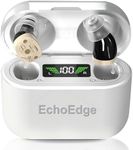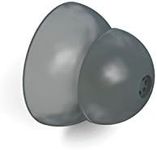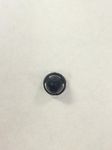Buying Guide for the Best Hearing Aids
Choosing the right hearing aid is crucial for improving your quality of life, as it can significantly enhance your ability to hear and communicate effectively. When selecting a hearing aid, it's important to consider your specific hearing needs, lifestyle, and preferences. Understanding the key specifications will help you make an informed decision that best suits your hearing loss and daily activities.Type of Hearing AidHearing aids come in various types, including behind-the-ear (BTE), in-the-ear (ITE), in-the-canal (ITC), and completely-in-canal (CIC). The type of hearing aid is important because it affects comfort, visibility, and the level of hearing loss it can accommodate. BTE models are generally more powerful and suitable for severe hearing loss, while ITE and ITC models are more discreet and suitable for mild to moderate hearing loss. Consider your level of hearing loss, comfort preferences, and whether you prefer a more discreet option when choosing the type.
Sound QualitySound quality in hearing aids refers to how well the device can reproduce clear and natural sound. This is important because it affects your ability to understand speech and enjoy sounds in different environments. Sound quality can vary based on the technology used, such as digital signal processing and noise reduction features. Look for hearing aids that offer advanced sound processing capabilities if you frequently find yourself in noisy environments or need to hear subtle sounds clearly.
Battery LifeBattery life indicates how long a hearing aid can operate before needing a recharge or battery replacement. This is important for convenience and ensuring your hearing aid is always ready to use. Battery life can range from a few days to several weeks, depending on the type of battery and usage. If you have an active lifestyle or travel frequently, consider hearing aids with longer battery life or rechargeable options to minimize the hassle of frequent battery changes.
ConnectivityConnectivity refers to a hearing aid's ability to connect with other devices, such as smartphones, TVs, or computers. This is important for streaming audio directly to your hearing aids and for making adjustments via an app. Connectivity options can include Bluetooth or proprietary wireless technologies. If you enjoy listening to music, watching TV, or making phone calls, look for hearing aids with robust connectivity features to enhance your listening experience.
Comfort and FitComfort and fit are crucial for ensuring that you can wear your hearing aids for extended periods without discomfort. This is important because a poorly fitting hearing aid can cause irritation and may not function optimally. Hearing aids come in various sizes and shapes, and some offer customizable ear molds. Consider trying different styles and sizes to find the most comfortable fit for your ear shape and size, ensuring that the device stays securely in place during daily activities.
Noise ReductionNoise reduction is a feature that helps minimize background noise, making it easier to focus on speech and important sounds. This is important for improving communication in noisy environments, such as restaurants or crowded places. Noise reduction capabilities can vary, with some hearing aids offering more advanced algorithms to distinguish between speech and noise. If you often find yourself in challenging listening environments, prioritize hearing aids with strong noise reduction features.









